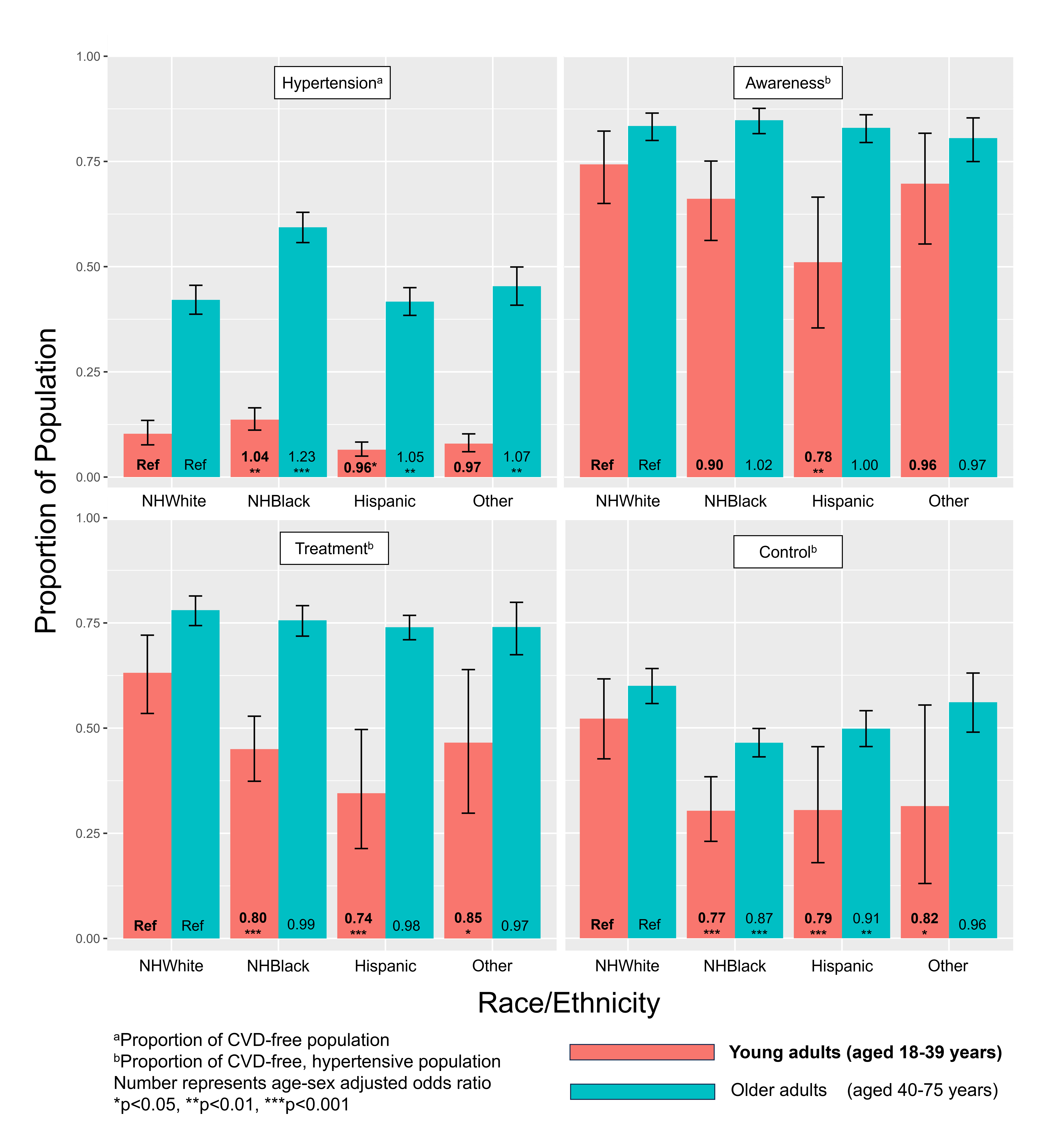Final ID: P3073
Racial/Ethnic Disparities in the Hypertension Control Cascade Among U.S. Young Adults
Abstract Body: Introduction
Treating hypertension in young adulthood can reduce the cumulative burden of elevated BP and prevent end organ damage. Despite marked improvements in from 2000-2010, hypertension prevalence, awareness, treatment, and control rates (the ‘hypertension control cascade’) plateaued among US adults after 2010. No recent study has examined trends in young adult hypertension control across race/ethnicity groups.
Objective
We aimed to estimate the prevalence of hypertension control cascade elements by age-group and race/ethnicity in CVD-free U.S. adults, using contemporary data.
Methods
Analyses were completed with 2015-March 2020 NHANES data. Survey-weighted logistic regression estimated the odds ratio for race/ethnicity and each element of the hypertension control cascade, adjusting for age and sex. Analyses were completed separately for young and older adults. Finally, we projected the total number of young adults living with hypertension and uncontrolled hypertension by combining prevalence data, the proportion of each age-group that was CVD-free, and population estimates from the U.S. census bureau.
Results
Hypertension prevalence was substantially higher for older adults compared to young adults (44% vs 9.7%). Rates of awareness (83% vs 70%), treatment (77% vs 55%), and control (56% vs 43%) were higher for older versus younger adults. Around 9.4M (95% CI: 7.1M-11M) CVD-free young adults have hypertension, of whom, around 5.3M (95% CI: 4.7-6.0M) have uncontrolled hypertension.
Compared to Non-Hispanic White (NHW) young adults, Non-Hispanic Black (NHB) counterparts had a significantly elevated likelihood of having hypertension (odd ratio [OR]: 1.04, 95% CI 1.01-1.07). Among those with hypertension, NHB young adults also had significantly lower likelihood of hypertension treatment (OR 0.80, 95% CI: 0.71-0.90) and control (OR 0.77, 95% CI 0.68-0.87). Similarly, Hispanic young adults had significantly lower likelihood of hypertension awareness (OR 0.78, 95% CI: 0.67-0.92), treatment (OR 0.74, 95% CI: 0.64-0.85), and control (OR 0.79, 95% CI: 0.69-0.90).
Conclusion
Rates of hypertension control are significantly lower for young adults and especially for those from racial/ethnic minority groups. This likely leads to disparity in later life health outcomes. Unequal hypertension control across racial/ethnic groups in older adulthood may be partly explained by differences in awareness and treatment in young adulthood.
Treating hypertension in young adulthood can reduce the cumulative burden of elevated BP and prevent end organ damage. Despite marked improvements in from 2000-2010, hypertension prevalence, awareness, treatment, and control rates (the ‘hypertension control cascade’) plateaued among US adults after 2010. No recent study has examined trends in young adult hypertension control across race/ethnicity groups.
Objective
We aimed to estimate the prevalence of hypertension control cascade elements by age-group and race/ethnicity in CVD-free U.S. adults, using contemporary data.
Methods
Analyses were completed with 2015-March 2020 NHANES data. Survey-weighted logistic regression estimated the odds ratio for race/ethnicity and each element of the hypertension control cascade, adjusting for age and sex. Analyses were completed separately for young and older adults. Finally, we projected the total number of young adults living with hypertension and uncontrolled hypertension by combining prevalence data, the proportion of each age-group that was CVD-free, and population estimates from the U.S. census bureau.
Results
Hypertension prevalence was substantially higher for older adults compared to young adults (44% vs 9.7%). Rates of awareness (83% vs 70%), treatment (77% vs 55%), and control (56% vs 43%) were higher for older versus younger adults. Around 9.4M (95% CI: 7.1M-11M) CVD-free young adults have hypertension, of whom, around 5.3M (95% CI: 4.7-6.0M) have uncontrolled hypertension.
Compared to Non-Hispanic White (NHW) young adults, Non-Hispanic Black (NHB) counterparts had a significantly elevated likelihood of having hypertension (odd ratio [OR]: 1.04, 95% CI 1.01-1.07). Among those with hypertension, NHB young adults also had significantly lower likelihood of hypertension treatment (OR 0.80, 95% CI: 0.71-0.90) and control (OR 0.77, 95% CI 0.68-0.87). Similarly, Hispanic young adults had significantly lower likelihood of hypertension awareness (OR 0.78, 95% CI: 0.67-0.92), treatment (OR 0.74, 95% CI: 0.64-0.85), and control (OR 0.79, 95% CI: 0.69-0.90).
Conclusion
Rates of hypertension control are significantly lower for young adults and especially for those from racial/ethnic minority groups. This likely leads to disparity in later life health outcomes. Unequal hypertension control across racial/ethnic groups in older adulthood may be partly explained by differences in awareness and treatment in young adulthood.
More abstracts on this topic:
2-Methoxyestradiol By Inhibiting Central Action of 12S-Hydroxyeicosatetraenoic Acid Protects Ovariectomized Mice From Hypertension
Dutta Shubha, Singh Purnima, Song Chi Young, Shin Ji Soo, Malik Kafait
Alcohol Use and Hypertension in the Eastern CaribbeanFraser Katharine, Acosta Lisbette, Galusha Deron, Maharaj Rohan, Oladele Carol

